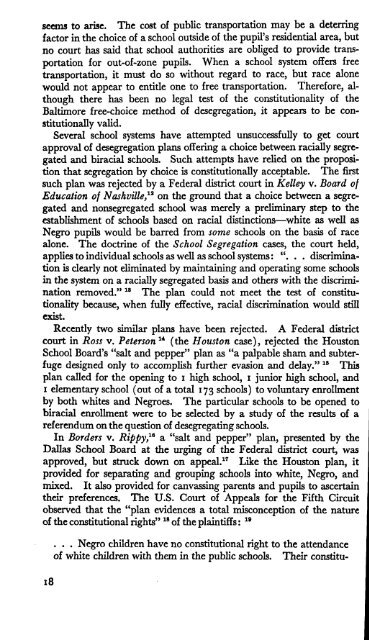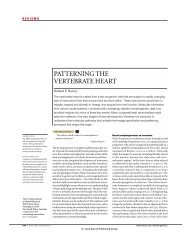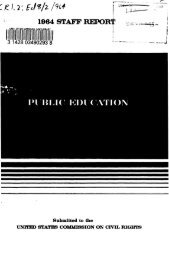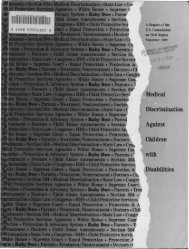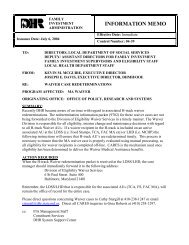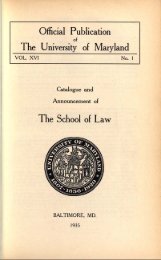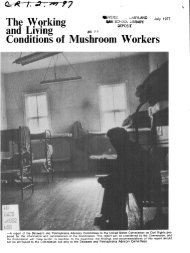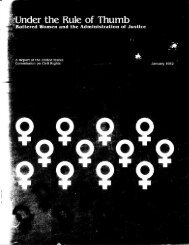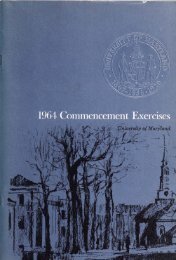1961 US Commission on Civil Rights Report Book 2 - University of ...
1961 US Commission on Civil Rights Report Book 2 - University of ...
1961 US Commission on Civil Rights Report Book 2 - University of ...
You also want an ePaper? Increase the reach of your titles
YUMPU automatically turns print PDFs into web optimized ePapers that Google loves.
seems to arise. The cost <strong>of</strong> public transportati<strong>on</strong> may be a deterring<br />
factor in the choice <strong>of</strong> a school outside <strong>of</strong> the pupil's residential area, but<br />
no court has said that school authorities are obliged to provide transportati<strong>on</strong><br />
for out-<strong>of</strong>-z<strong>on</strong>e pupils. When a school system <strong>of</strong>fers free<br />
transportati<strong>on</strong>, it must do so without regard to race, but race al<strong>on</strong>e<br />
would not appear to entitle <strong>on</strong>e to free transportati<strong>on</strong>. Therefore, although<br />
there has been no legal test <strong>of</strong> the c<strong>on</strong>stituti<strong>on</strong>ality <strong>of</strong> the<br />
Baltimore free-choice method <strong>of</strong> desegregati<strong>on</strong>, it appears to be c<strong>on</strong>stituti<strong>on</strong>ally<br />
valid.<br />
Several school systems have attempted unsuccessfully to get court<br />
approval <strong>of</strong> desegregati<strong>on</strong> plans <strong>of</strong>fering a choice between racially segregated<br />
and biracial schools. Such attempts have relied <strong>on</strong> the propositi<strong>on</strong><br />
that segregati<strong>on</strong> by choice is c<strong>on</strong>stituti<strong>on</strong>ally acceptable. The first<br />
such plan was rejected by a Federal district court in Kelley v. Board <strong>of</strong><br />
Educati<strong>on</strong> <strong>of</strong> Nashville, 13 <strong>on</strong> the ground that a choice between a segregated<br />
and n<strong>on</strong>segregated school was merely a preliminary step to the<br />
establishment <strong>of</strong> schools based <strong>on</strong> racial distincti<strong>on</strong>s—white as well as<br />
Negro pupils would be barred from some schools <strong>on</strong> the basis <strong>of</strong> race<br />
al<strong>on</strong>e. The doctrine <strong>of</strong> the School Segregati<strong>on</strong> cases, the court held,<br />
applies to individual schools as well as school systems: ". . . discriminati<strong>on</strong><br />
is clearly not eliminated by maintaining and operating some schools<br />
in the system <strong>on</strong> a racially segregated basis and others with the discriminati<strong>on</strong><br />
removed." 18 The plan could not meet the test <strong>of</strong> c<strong>on</strong>stituti<strong>on</strong>ality<br />
because, when fully effective, racial discriminati<strong>on</strong> would still<br />
exist.<br />
Recently two similar plans have been rejected. A Federal district<br />
court in Ross v. Peters<strong>on</strong> 1 * (the Houst<strong>on</strong> case), rejected the Houst<strong>on</strong><br />
School Board's "salt and pepper" plan as "a palpable sham and subterfuge<br />
designed <strong>on</strong>ly to accomplish further evasi<strong>on</strong> and delay." " This<br />
plan called for the opening to I high school, I junior high school, and<br />
i elementary school (out <strong>of</strong> a total 173 schools) to voluntary enrollment<br />
by both whites and Negroes. The particular schools to be opened to<br />
biracial enrollment were to be selected by a study <strong>of</strong> the results <strong>of</strong> a<br />
referendum <strong>on</strong> the questi<strong>on</strong> <strong>of</strong> desegregating schools.<br />
In Borders v. Rippy 19 a "salt and pepper" plan, presented by the<br />
Dallas School Board at the urging <strong>of</strong> the Federal district court, was<br />
approved, but struck down <strong>on</strong> appeal. 17 Like the Houst<strong>on</strong> plan, it<br />
provided for separating and grouping schools into white, Negro, and<br />
mixed. It also provided for canvassing parents and pupils to ascertain<br />
their preferences. The U.S. Court <strong>of</strong> Appeals for the Fifth Circuit<br />
observed that the "plan evidences a total misc<strong>on</strong>cepti<strong>on</strong> <strong>of</strong> the nature<br />
<strong>of</strong> the c<strong>on</strong>stituti<strong>on</strong>al rights" 18 <strong>of</strong> the plaintiffs: 19<br />
18<br />
. . . Negro children have no c<strong>on</strong>stituti<strong>on</strong>al right to the attendance<br />
<strong>of</strong> white children with them in the public schools. Their c<strong>on</strong>stitu-


